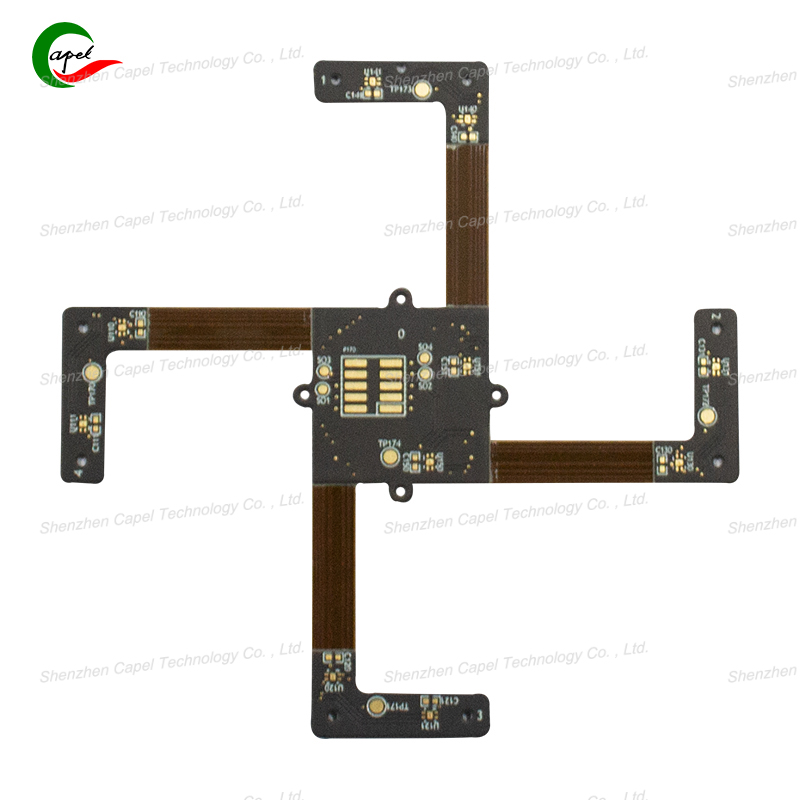Rigid-Flex PCBs vs. Pure Flexible PCBs: What Are the Advantages?
Date: 2025-10-07
Pure flexible PCBs excel at bending, but they struggle with supporting heavy components or staying stable in complex devices. Rigid-flex PCBs—combining flexible and rigid sections—fix these gaps. If you’re choosing between the two for a device (like a foldable phone or medical sensor), here’s a clear breakdown of why rigid-flex often works better—no confusing jargon, just practical benefits.
Pure flexible PCBs are thin and flimsy—they can’t hold heavy parts like batteries, CPUs, or large sensors without bending or breaking. Rigid-flex PCBs solve this with their rigid sections:
- How it works: Rigid sections (made of FR-4, the same stiff material as rigid PCBs) act as a “platform” for heavy components. The flexible sections handle bending, while the rigid parts keep weighty parts stable.
- Example: A wireless earbud needs a battery (0.5g, light but needs support) and a speaker (0.3g). A pure flexible PCB would sag under the battery, shifting the earbud’s balance. A rigid-flex PCB has a small rigid section for the battery and speaker, with a flexible section to bend around the earbud’s curve—no sagging, no shifting.
- Pure flexible limitation: Even with glue or tape, pure flexible PCBs can’t prevent heavy components from moving over time. This leads to loose connections or broken circuits.
Pure flexible PCBs often need extra parts (connectors, wires, brackets) to work with other components. Rigid-flex PCBs eliminate these, cutting assembly time and failure points:
- Fewer connectors: To link a pure flexible PCB to a battery or sensor, you need 2–4 connectors (male/female plugs). Rigid-flex integrates the flexible and rigid sections into one board—no connectors needed.
- Example: A smartwatch with a pure flexible PCB needs 3 connectors to link the screen, battery, and heart rate sensor. A rigid-flex smartwatch PCB combines these into one piece, removing 3 connectors.
- No extra wires or brackets: Pure flexible PCBs need wires to bridge gaps between moving parts (like a foldable phone’s hinge) and brackets to hold them in place. Rigid-flex’s flexible sections replace wires, and rigid sections replace brackets.

Pure flexible PCBs are delicate—vibration (like in a car, industrial machine, or even a running shoe) can cause their thin copper circuits to crack. Rigid-flex PCBs are tougher because of their rigid sections:
- How it works: Rigid sections absorb vibration, protecting the flexible sections and their circuits. The flexible parts bend to reduce stress, while the rigid parts keep the board stable.
- Example: A car’s door sensor experiences vibration every time the door slams. A pure flexible PCB here would develop cracked copper lines within 6 months. A rigid-flex PCB has a rigid section mounted to the door frame (absorbing slamming vibration) and a flexible section to bend when the door opens—lasting 3–5 years.
- Pure flexible limitation: Vibration makes pure flexible PCBs’ circuits rub against other components, wearing down the protective coating and causing short circuits. Rigid-flex’s rigid sections keep circuits away from friction points.
Pure flexible PCBs’ thin, bendable design can lead to signal interference—especially when they’re folded or close to metal parts. Rigid-flex PCBs improve signal reliability:
- How it works: Rigid sections can hold shielding (like thin copper layers) to block electromagnetic interference (EMI) from other components. Pure flexible PCBs rarely have space for shielding without losing flexibility.
- Example: A foldable phone’s pure flexible PCB near the speaker (which emits EMI) might have spotty audio signals. A rigid-flex PCB’s rigid section near the speaker includes EMI shielding, keeping audio signals clear.
- Why it matters: For devices that need consistent signals (like medical monitors or GPS trackers), interference can cause wrong readings or lag. Rigid-flex reduces signal issues by 30–50%.
Pure flexible PCBs can bend, but they still need extra room for connectors and brackets. Rigid-flex PCBs’ integrated design lets them fit into smaller, more complex spaces:
- Example: A tiny medical sensor (the size of a fingernail) needs to bend around a finger and hold a small battery. A pure flexible PCB would need a separate bracket for the battery, making the sensor too big. A rigid-flex PCB has a micro-rigid section for the battery and a flexible section to wrap around the finger—fitting the tight space.
- Pure flexible limitation: Adding brackets or connectors to pure flexible PCBs increases their overall size by 20–30%, making them unusable for ultra-small devices.
Pure flexible PCBs are great for simple, low-weight, low-vibration devices (like a smartwatch band’s LED strip). But for devices that need to bend and support components, reduce failure risks, or fit into tight spaces—rigid-flex PCBs are better. They combine the flexibility of pure flexible PCBs with the stability of rigid PCBs, cutting parts, simplifying assembly, and making devices more durable. If your device isn’t just “bending” but “working hard” (holding parts, handling vibration, sending clear signals), rigid-flex is the smarter choice.
related link:
